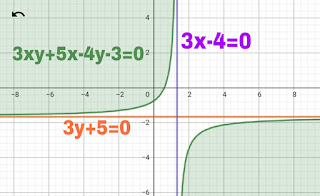A straight line L is called an asymptotes of an infinite branches of a curve if the perpendicular distance of a point P on that branch from the straight line L tend to zero as P moves to infinity along the branch. An asymptote of a curve is a line to which the curve converge. In other words, the curve and its asymptotes get infinity close but they never meet. They are use in graphing rational equation.
In most cases, the asymptotes of a curve can be found by taking the limit of a value where the function is not defined. Typical examples would be and or the point where the denominator of a rational function equals zero. Asymptotes are broadly classified into three categories
1. Horizontal asymptote
2. Vertical asymptote
3. Oblique asymptote
Vertical asymptote is a line which is parallel to y-axis. When x goes to infinity then curve approaches some constant value.
An asymptote, which is neither parallel to x-axis nor y-axis is called an oblique asymptote. When x goes to infinity then curve goes toward a line y=mx+c.
It should be noted properly that if coefficient of higher power of x in the equation of the given curve is a constant or has no real linear factor, then the curve has no asymptote parallel to x-axis.
It should be noted properly that if coefficient of higher power of y in the equation of the given curve is a constant or has no real linear factor, then the curve has no asymptote parallel to y-axis.

Sol.
The equation of the given curve is (1)
(1)
The coefficient of highest power of x in (1) is
In most cases, the asymptotes of a curve can be found by taking the limit of a value where the function is not defined. Typical examples would be and or the point where the denominator of a rational function equals zero. Asymptotes are broadly classified into three categories
1. Horizontal asymptote
2. Vertical asymptote
3. Oblique asymptote
1. Horizontal asymptote
Horizontal asymptote is a line which is parallel to x-axis. When x goes to infinity then curve approaches some constant value.2. Vertical asymptote
Vertical asymptote is a line which is parallel to y-axis. When x goes to infinity then curve approaches some constant value.
3. Oblique asymptote
An asymptote, which is neither parallel to x-axis nor y-axis is called an oblique asymptote. When x goes to infinity then curve goes toward a line y=mx+c.
☆Rule to find asymptotes parallel to x-axis
Equate to zero the real linear factor in the coefficient of higher power of x in the equation of the given curve.It should be noted properly that if coefficient of higher power of x in the equation of the given curve is a constant or has no real linear factor, then the curve has no asymptote parallel to x-axis.
☆Rule to find asymptotes parallel to y-axis
Equate to zero the real linear factor in the coefficient of higher power of y in the equation of the given curve.It should be noted properly that if coefficient of higher power of y in the equation of the given curve is a constant or has no real linear factor, then the curve has no asymptote parallel to y-axis.
Example
Q1. Find the vertical and horizontal asymptotes of the curveSol.
The equation of the given curve is
The coefficient of highest power of x in (1) is
Horizontal asymptote of given curve is
The coefficient of highest power of y in (1) is
Vertical asymptote of the given curve is
Oblique asymptotes
Rule to find oblique asymptotes
(1). Find
(2). Find
Then
Example
Q2. Find the asymptotes of the curveSol.
Here equation of the curve is
Or
Or
The coefficient of highest power of x is 1, which is constant.
Given curve has no asymptote parallel to x-axis
The coefficient of highest power of y is -x
The asymptote of given curve parallel to y-axis is -x=0 or x=0
Let us now find the oblique asymptote
To determine m and c :
Therefore oblique asymptote is given by
Hence the given curve has two asymptotes given by
☆Rule to find the asymptotes of a rational algebraic curve :
Step1. FindStep2. Find all real roots of
Step3. If m₁ is non-repeated root of
If
Step4. If m₁ is a repeated root occurring twice, then corresponding values of c are given by
In this case there are two parallel asymptotes to the curve.
Similarly we can proceed when m₁ is repeated three or more times.
Example
Q3. Find the asymptotes of the curveSol.
The equation of given curve is
The coefficient of highest power of x in (1) is 1, which is constant.
There is no asymptotes parallel to x-axis
The coefficient of highest power of y in (1) is -2, which is constant
There is no asymptotes parallel to y-axis
For oblique asymptotes
[Putting x=1 and y=m in degree 3 term]
Now
When m=1,
Corresponding asymptotes is y=x, or x-y=0
When m=-1,
Corresponding asymptotes is y=-1x-1 i.e., x+y+1=0
When
Corresponding asymptotes is
Hence asymptotes of the given curve are

















Postgraduate research is no easy journey, and this article does a great job addressing that. When deadlines get overwhelming, students often turn to Thesis Writing Help to stay on track. These services are not shortcuts but support systems that help with structure, citations, and academic tone. A reliable provider will guide students without doing the entire work for them. It’s all about enhancing your research and presentation. This blog’s explanation of how to use such services ethically is refreshing. Definitely sharing this with peers working on their dissertations!
ReplyDelete